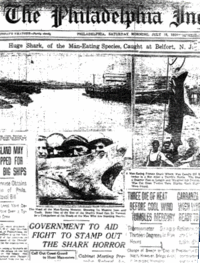The Jersey Shore shark attacks of 1916 were a series of shark attacks along the coast of New Jersey between July 1 and July 12, 1916, in which four people were killed and one injured. Since 1916, scholars have debated which shark species was responsible and the number of animals involved, with the great white shark and the bull shark most frequently being blamed. The attacks occurred during a deadly summer heat wave and polio epidemic in the northeastern United States that drove thousands of people to the seaside resorts of the Jersey Shore. Shark attacks on the Atlantic Coast of the United States outside the semitropical states of Florida, Georgia, and the Carolinas were rare, but scholars believe that the increased presence of sharks and humans in the water led to the attacks in 1916.
Local and national reaction to the attacks involved a wave of panic that led to shark hunts aimed at eradicating the population of "man-eating" sharks and protecting the economies of New Jersey's seaside communities. Resort towns enclosed their public beaches with steel nets to protect swimmers. Scientific knowledge about sharks before 1916 was based on conjecture and speculation. The attacks forced ichthyologists to reassess common beliefs about the abilities of sharks and the nature of shark attacks.
The Jersey Shore attacks immediately entered into American popular culture, where sharks became caricatures in editorial cartoons representing danger. The attacks inspired Peter Benchley's novel Jaws (1974), an account of a great white shark that torments the fictional coastal community of Amity. Jaws was made into an influential film in 1975 by Steven Spielberg. The attacks became the subject of documentaries for the History Channel, Discovery Channel, and National Geographic Channel.
